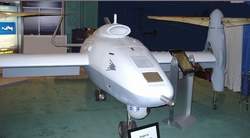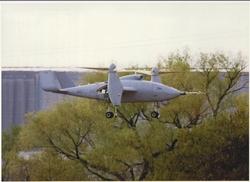It's an 'Osprey' We're Not Afraid to Fly
OK -- that's not fair. This little guy has been flying, and it's
doing well. The Bell Eagle Eye Tiltrotor UAV (BEET-U? no; it's the
"TR911D") is a new concept in what Bell hopes to be the next
generation of ship-based surveillance machinery.
 The
single-engine (PW200-55) baby was originally presented to the Navy,
about ten years ago, but lost the competition to what is now the
Fire Scout. Now, Bell is working on
the Coast Guard for deepwater deployment; and there's talk that
Lockheed Martin may someday become part of the mix, as well.
The
single-engine (PW200-55) baby was originally presented to the Navy,
about ten years ago, but lost the competition to what is now the
Fire Scout. Now, Bell is working on
the Coast Guard for deepwater deployment; and there's talk that
Lockheed Martin may someday become part of the mix, as well.
The Eagle Eye first flew in low tethered hover in 1989,
according to Bell's Brent Achttien, whom we met at the Association
for Unmanned Vehicle Systems International (AUVSI) exhibition,
which opens today in Orlando (FL). After five years of
on-and-off development, the project had accumulated 26 flight
hours, and was moved to Yuma (AZ), where it languished, as
resources were deployed on other projects. In 1998, Bell conducted
a 50+ hour test regimen over 90 days, without a single mishap.
The props are small, but still, vertical takeoffs and landings
are the only way to fly. This fully-autonomous machine can take
off, rise (to about 100 feet), transition to horizontal flight, fly
its mission, and return, hovering and then lowering itself at
something less than 10 feet per second (vertical) into ground
effect (the last five feet or so), whence it lands.
 Even
though there will never be a human on board, the Bell Eagle Eye has
full dual redundancy on all controls (even throttle). There is also
an override system, run by a human pilot, through Futaba controls.
This system is used to start the engine, and to take the machine to
its initial 100-foot hover, from where it transitions on its own to
horizontal flight, and completes its mission, all under the
influence of GPS, of course.
Even
though there will never be a human on board, the Bell Eagle Eye has
full dual redundancy on all controls (even throttle). There is also
an override system, run by a human pilot, through Futaba controls.
This system is used to start the engine, and to take the machine to
its initial 100-foot hover, from where it transitions on its own to
horizontal flight, and completes its mission, all under the
influence of GPS, of course.
"It's small and quiet, too," said Jerry Massey, who is another
of Bell's "Wizards of Ft Worth," as he helped with the display
setup. It's small enough to fly from a Coast Guard 270-class ship,
the smallest practical Coast Guard platform for the Eagle Eye, in
Bell's estimation.
To get an idea of just how small this machine is, note that its
wingspan is just over 15 feet; instead of the 38-footers of the
Osprey, it's carrying three-bladed 9.5-foot rotors. Though it
really likes a 36-foot-square "airstrip" for operations, it's
extremely compact; and its nose, tail, and wings all fold.
Just six people can operate as many as four Eagle Eyes,
simultaneously -- and training is, as you would expect, 'way
simpler (and quicker and cheaper) than with anything like a manned
equivalent.
What'll It Do?
 So
far, the twin-tail Eagle Eye has demonstrated its capabilities in
low flight, vertical flight, hover, and transition. It has
navigated and returned to its exact takeoff point, autonomously. It
has also flown at density altitudes of 15,000 feet (Bell says
it'll fly OK at 20,000), where it has demonstrated level flight at
200 knots.
So
far, the twin-tail Eagle Eye has demonstrated its capabilities in
low flight, vertical flight, hover, and transition. It has
navigated and returned to its exact takeoff point, autonomously. It
has also flown at density altitudes of 15,000 feet (Bell says
it'll fly OK at 20,000), where it has demonstrated level flight at
200 knots.
Currently, its useful payload is about 200 pounds. With a
representative fuel load, she'll stay in the air just under four
hours. Maintenance, unlike most rotorcraft, takes a tiny bit less
than an hour, for each hour of flight.
We'll keep you informed, as this little composite ship performs
more air trials...
Anything Else New?
While it's not a UAV, it's an interesting Bell development.
Would anyone like to see a "Quad Tiltrotor?" It's a two-winged
tiltrotor, with four engines -- get this -- it's roughly the size,
and has the carrying capacity, of a C-130! No -- we don't
have a photo of that one. It's in the concept stage.
 ANN's Daily Aero-Term (04.25.24): Airport Rotating Beacon
ANN's Daily Aero-Term (04.25.24): Airport Rotating Beacon ANN's Daily Aero-Linx (04.25.24)
ANN's Daily Aero-Linx (04.25.24) Klyde Morris (04.22.24)
Klyde Morris (04.22.24) Airborne 04.24.24: INTEGRAL E, Elixir USA, M700 RVSM
Airborne 04.24.24: INTEGRAL E, Elixir USA, M700 RVSM Airborne 04.22.24: Rotor X Worsens, Airport Fees 4 FNB?, USMC Drone Pilot
Airborne 04.22.24: Rotor X Worsens, Airport Fees 4 FNB?, USMC Drone Pilot





